Knife Reviews & Articles
SCHATT & MORGAN
SERIES XV SAMBAR STAG CARPENTER'S WHITTLER
Specifications
Length closed: 3-1/2"
Length (open): 5-3/4"
Blade length:
- Master Sheepsfoot: 2-3/16"
- Small Clip 1-5/8"
- Coping 1-5/8"
Steel: 420HC
Number produced: 600
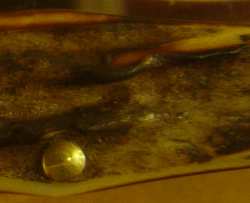
Only Sambar Stag has this appearance
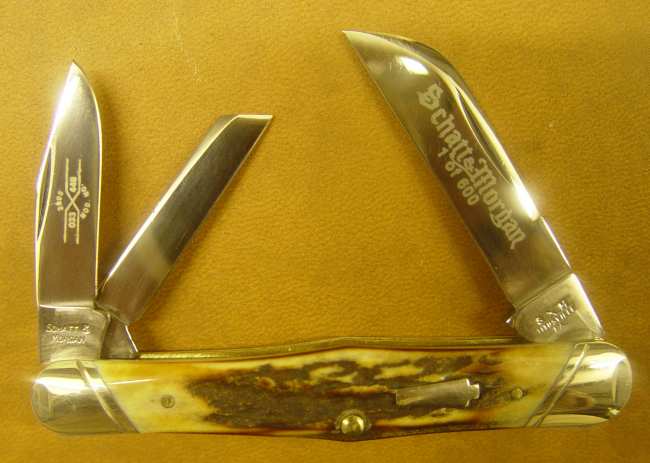
With any knife, first impressions count. This one just cannot fail to impress. Sambar Stag is the bees knees. The ultimate traditional handle material. At a time when most production knife manufacturers cannot obtain real Sambar Stag (since the embargo on exports from India), Queen Cutlery have managed to source enough of it for 600 of these knives. I strongly suspect that the Sambar Stag didn't come from India and isn't old stock, but this animal is found in adjacent countries and also in Malaysia. I have little doubt that it now costs more to source the antler material, but it just goes to show that it is out there and available to knife manufacturers if they are willing to pay the higher price. This Schatt & Morgan whittler has the real stuff. Its exactly what we like, and its gorgeous.
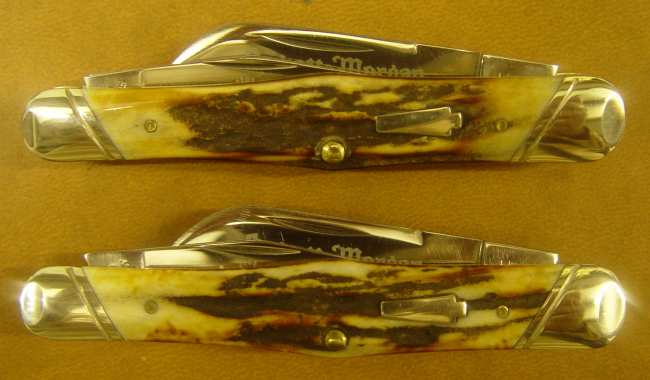
Note how the surface of the stag has been burnt (singed with a torch) to give it extra colour.
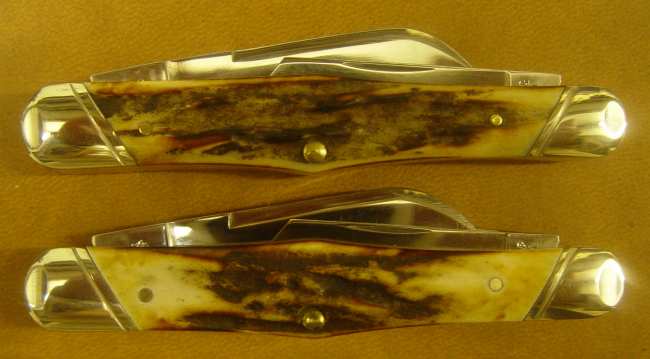
The upper knife in the photographs has thinner stag scales, the lower one has thicker scales. Note how, especially on the back of the knife (photo above) that the thicker handled knife has had more of the natural stag surface removed to bring it down to the bolsters. Which you prefer is up to you. Thick with less natural surface, or slender with more natural surface.


The S&M Titusville PA tang stamp
Craftsmanship
The Blades
The blades are made of 420HC steel. This is one of the stainless steels. Actually I am a little surprised that for such an up-market classic knife such as this, Queen Cutlery didn't use either D2, 1095 high carbon or even ATS-34. But certainly 420HC is a very usable steel, and is much less prone to rusting. Those who like whittling would perhaps prefer a slightly springier 1095, especially on the small clip blade which would see the most use, whereas 420HC is a little stiffer. The sheepsfoot blade is both strong and stiff, and will be ideal for a large range of every-day tasks. All of the blades came out of the box sharp enough to shave hairs off your arm. Close inspection with an X10 magnifying glass shows the business edge to be convex ground rather than flat, which I would prefer, but a few strokes on a soft Arkansas stone will bring those into line, and also produce a smoother cutting edge. I don't count that as a negative point, but just a matter of personal preference.
The master sheepsfoot blade is a little on the stiff side to open. It opens easily to the half way point, but from there to fully open it is quite hard against the backsprings. That main blade works against both the backsprings, and they are perhaps a little too strong. From the half open position you need to grasp the blade firmly between finger and thumb to pull it into the fully open position, and I never feel too comfortable doing that, as with a small blade such as this I always get the feeling that my fingers are too close to the business edge. It may loosen up with use though.
One of the features about these blades, is that they are not designed to have a true half stop position, but they sort of do. There's about 10 degrees of play either side of the half position, due to the back of the tang being slightly rounded rather than flat. True half-stop knives literally snap into that position, but these don't.
This is a "splitback" whittler. That means that the two smaller blades each have their own backspring, and that the master blade works against both springs. Between the springs is a wedge of brass. Overall therefore, the bolster at the master blade end is thinner than at the two blade end.
Bolsters
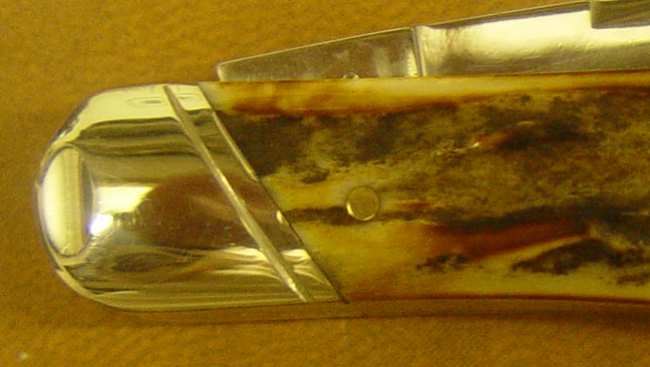
The bolsters are, for want of a better word, pulchritudinous. (Hey! look it up, and then use the same word to your woman to tell her how gorgeous she looks). Its perfection in beauty. Three great features in design here. Angled bolsters, the groove, and the "pinched" ends. The best features in knife bolsters all in one knife. Someone at Queen took the trouble to specify that design, and there are of course extra processes involved in making them. The idea is far from being new. Its the sort of thing that you would find on the highest quality knives of the 1800s.
Sharpening
One of these two knives is going to be a "user", and therefore I reprofiled the edges slightly to a shallower angle, and finished them on a hard translucent Arkansas stone. This steel sharpens pretty easily, but doesn't keep its edge quite as easily as a D2 or ATS-34. But I'm not complaining. (I'll admit to being prejudiced however, in that I prefer either 1095 high carbon in my knives or the ATS-34).
General fit and finish
The general fit and finish on the two knives is excellent. There are no gaps whatsoever between the liners and the scales or springs. One point that I always look for is the radius of the ends, and these are nicely finished with no stepping or grind marks. Both knives, however, do suffer from that "Queen feature" of having a sharp edge to the back of the tang where it protrudes above the handles in the closed position. I am certainly going to round that corner off slightly with a stone before it digs a hole in the liners of my pocket. Blade separation in the closed position is perfect. There's no way that you are going to see any blade rub with this knife.
This knife is more than just a tool. It is a joy to look at too. Some materials, particularly the handle materials, can make a knife stand out from the others. Certainly this genuine natural Sambar Stag really stands out from the crowd. Queen Cutlery (who make the Schatt & Morgan knives as their premier range) have selected some really great stag. When I bought these two knives, I had the opportunity to see several examples, and frankly, they were all fantastic, with little to choose between them.
Cost and Value
These knives sell at a dealer price of $99.00, and are listed as the Schatt & Morgan Carpenters Whittler - Series XV
Value: 10/10
An excellent knife with a traditional look and feel, and everything going for it. Boy, do I enjoy doing reviews of knives as good as this one! And I'm going to enjoy carrying and using it too. It's just what a pocket knife should be.
These knives were obtained from Bill Horn at Cumberland Knife Works -see the 2005 XV series on his web pages
June 2005
Copyright ©2005 Rod Neep All Rights Reserved
Photographs by Rod Neep